Vic (aka Vich) is a fantastic train accessible tourist day trip from Barcelona being a compact town with a historic walled centre that retains most of it’s medieval buildings and street layout. Vic, the capital of the Osona county, can be found 69 kilometres (42 miles) inland in a large mountain surrounded plain halfway between Barcelona and the Pyrenees.

Plaza Major de Vic
Vic has a good collection of museums and monuments that cover diverse subjects and easily fill a whole day of tourism. The construction of the Transpirinenc railway in 1875 from Barcelona to Vic (today known as the R3 Rodalies line) as well as the Regular bus service make this town easy for non-Spanish speakers to visit. The tourism office also provides plenty of free information brochures in multiple languages.
The origins of the town of Vic date from the 4th Century BC when a settlement was founded by an Iberian tribe known as the Ausa. The town fell under roman Rule and later Visgoth rule. Vic was completely destroyed by fire in 826 in a battle with the Saracens. Since then, Vic has thrived and grown into a prosperous town thanks to industries like leather and meat (sausage) production.
Food wise, if you are tired of paella and seafood then a day trip to Vic is what your stomach needs. Vic is famous for meat products such as llonganissas (long thin chorizo like sausage that is served sliced and cold or hot), fuet (peppered sausages served sliced and cold) and Butifarra (pork Sausage served hot with Ali-Oli garlic and mayonnaise sauce and white beans).
Prepare to travel back in time and discover an authentic medieval town with some very Catalan traditions that is my personal recommendation for a winter day trip.
Plaça Major

Vic Cathedral
When you first arrive in Vic you will follow a broad street from the train station and arrive at a large public square that hosts a food and clothing market in the mornings. The plaza major is one of the largest medieval galleried squares in Europe. Cross this square and head straight to the tourism office in the town hall building (former wheat grain exchange) to load up on free brochures (town map, walking route, museums guide) We will revisit the market later after the market has been cleared away at 4pm.
Vic Cathedral

Vic Cathedral
Saint Peter the Apostle cloistered cathedral dates from 1781 with the bell tower being of earlier Roman origin. The cathedral is typical Romanesque round arches but the cloister dates from the 14th century and has gothic arches. The cathedral has modest decoration with frescos high up on the walls and gilded columns with ornate ironwork. The cathedral is free to visit with a €3 surcharge to visit the cloisters. I recommend the cloister visit for the small antechambers access and to visit behind the cathedral alter to see the carved altar piece.
MEV
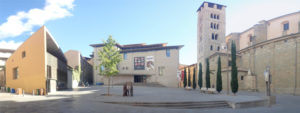
Vic MEV Museum
Museo Episcopal de Vic could best be described as a medieval religious art museum preserving a vast range of works such as oil on wood (red and other earthy colours) oil on canvas, wood carvings (from altars, doorways, pews and more), stone carvings (bosses and statues), ironworks, pottery, glass, and many other decorative items.
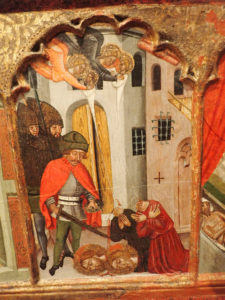
Vic MEV Museum
Even if you are not particularly religious, this four-floor museum has a diverse range of artefacts that will provide visual stimuli. Note that in medieval times when literacy among the general population was not prevalent, paintings and drawings were how the church conveyed moral and religious instruction and this museum has a large selection of bizarre and sometimes disturbing imagery.
Roman Temple

Vic Roman Temple
Is it fake or real? Both! The roan temple is a modern (1953) reconstruction of the Roman Temple of Vic built from stone and original columns that were buried under the Vic medieval castle ruins. The castle was built on top of the foundation of the Roman temple and later fell into ruin. During a period of redevelopment, the temple foundations were discovered and so the temple was reconstructed from stone found in the castle ruins which was built from the original 4BC Roman temple. The temple is actually a modern art gallery and only open on the weekends in the mornings.
Leather Arts Museum

Vic MEV museum
The traditional industries of Vic were leather tanneries and leather goods production with the town being renowned across Europe for its products from such brands as Munmany. The town actually had 25 tanneries at its peak. The Vic Leather arts museum exists to house the personal collection of Andreu Colomer Mommany who with his wife was a passionate collector of leather artefacts from across the globe during their many travels. Within this museum you will find artefacts from Asia, northern Europe, Arabic southern Spain and Africa.
Vic as a winter destination
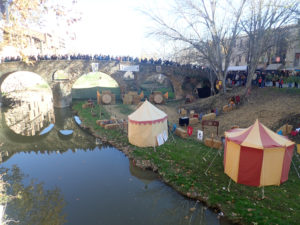
Vic Pont de Queralt medieval fair
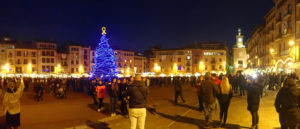
Vic Plaza major Christmas
Vic is a town that hosts many events but my personal pick is the medieval market fair in early December. The historic town centre hosts medieval markets, craftsmen, taverns and street performances which makes it the perfect time of year to visit.
As you walk around Vic you will see many statues or figurines of old people, possibly with a witch like appearance, these a Gegants. A very important element in the local festivals of many Catalan towns are the parades of the giants (gegants) and big-heads (capgrossos), large figures carried by people. They represent popular archetypes, representative animals or historical figures of local importance. In Vic the giants are wise old people. They are typically caricature figures with excessively large heads in relation to the body.
For as more detailed breakdown of Vic tourism with maps, walking route, restaurant guides, historic buildings list and detailed museum reviews I recommend checking out my day trip guide article.



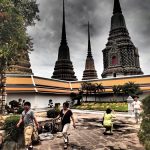
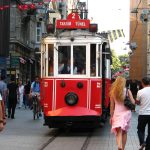
Leave a Reply